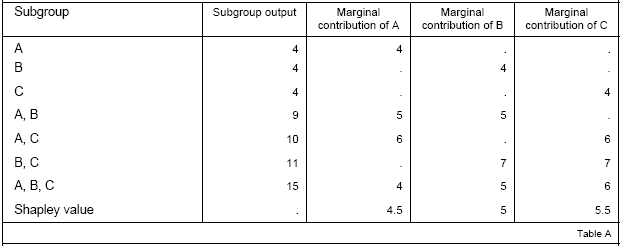Shapley value allocation methodology: a specific example
(Extract from page 77 of BIS Quarterly Review, September 2009)
This box illustrates the Shapley value allocation methodology by reference to a specific numerical example where three parties (A, B and C) can cooperate to generate a measurable outcome. If nobody participates nothing is produced, and each participant alone can produce 4 units. The output of each possible grouping of the three participants is detailed in the left-hand column of the table below.
The marginal contribution of a player to a subgroup is calculated as the output of the subgroup minus the output of the same subgroup excluding the individual participant. For instance, the marginal contribution of A to the output of the overall group (A, B, C) is equal to the difference between 15, which is the overall group’s output, and 11, which is the output of B and C together.
The Shapley value of each player is the average of its marginal contributions across all differently sized subgroups. For example, the value of B is equal to 5 (see bottom row). It is calculated as the average of 4, which is its individual output, 6, which is the mean contribution it makes to subgroups of size two, and 5, which is its marginal contribution to the overall group. The calculation can also be motivated as the expected marginal contribution of an individual participant in groups that are formed randomly by sequentially selecting players (see Mas-Colell et al (1995)).

